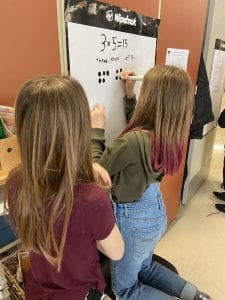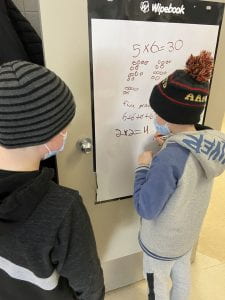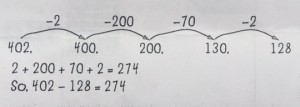Today we began exploring division as equal groups. Here is a short video lesson if you wish to see an example of what we learned today.
Earth Week Activities
Earth Week Activities- April 19-23
Mindful Monday– We will discuss what Earth Day is all about and reflect on the beauty of our earth and the need to take care of it and protect it.
Turn it Off Tuesday – As a school, we will encourage all classes to make little changes to raise awareness that little changes lead to big improvements for our earth. We will turn some lights off in the school to conserve energy.
Waste-free Wednesday– We are encouraged to bring a lunch with no waste or garbage. Reusable containers are encouraged (emphasize water bottles as apposed to using the plastic cups).
Thankful Thursday – We will discuss what they are thankful for in our earth.
Friendly Friday– We will do an act of kindness for our community and our earth by cleaning up around our school and neighbourhood.
Multiplying Together
Yesterday, we did some partner work around the classroom to help us remember the math concepts we learned before the break. Working with classmates certainly makes learning a lot more fun and engaging!





Multiplication
Just in case you are curious, these short video lesson include most of the multiplication skills we have learned to this point. Our multiplication unit in grade three is a basic introduction to the concept.
https://drive.google.com/open?id=1LzysItBIYXyq2C4JC66bOTyV3kPI_B1a&authuser=0
https://drive.google.com/open?id=1JZ6WrDXBKQ8OTyxkt6gL4sfnGNfq03_e&authuser=0
Important Dates in April:
Monday, April 12 – Students return to classes
Monday, April 19 – Story Walk questions due
– Earth Week activities begin (Mindful Monday)Tuesday, April 20 – Turn it off Tuesday
Wednesday, April 21 – Waste Free Wednesday
Thursday, April 22 – Thankful Thursday
Friday, April 23 – Friendly Friday
Multiplication and Division
Our class started a mathematics unit on multiplication and division. Multiplication and division are basic computational skills that children must eventually master in order to succeed in higher levels of mathematics. The focus of this unit is on developing an understanding of the processes of multiplication and division in order to develop strategies for multiplying and dividing whole numbers up to 5×5. Children will use counters, number lines, and arrays to develop their understanding.
In this unit, your child will:
- Model multiplication and division up to 5 x 5
- Find strategies to multiply and divide up to 5 x 5
- Pose and solve story problems involving multiplication and division.
Encourage your child to share different strategies used to multiply and divide.
We use multiplication and division in many day-to-day situations.
Here are some suggestions for activities you can do at home:
- Look for things that come in groups of 2, 3, 4, and 5. Create problems. For example: Bikes have 2 tires. How many tires are on 4 bikes?
- Use a deck of playing cards, using only the 1s (Aces) to 5s. Shuffle the cards. Flip the first card. This represents the number of groups. Flip the second card. This represents the number of objects in each group. Have your child draw a picture to match the cards, and write a multiplication and division sentence to match the picture. Continue until all cards are used up.
Rubber Boots Please…
Our playground is quite wet. Please send your child to school with rubber boots if you can. Also, maybe pack some extra socks just in case. The kids have been doing a good job of staying dry even though spring has provided many tempting puddles.
Addition and Subtraction Update:
Here is a quick overview of some of the skills we have been practicing in our Addition and Subtraction unit. We are working with 2 and three digit numbers now, but these are some of the important single digit strategies that we have reviewed. Sorry, this is a long blog post. I usually put this out in stages, but it has been a crazy year and I forgot!
1. Doubles and Near-Doubles Addition Facts: We spent quite a bit of time practicing our doubles facts as a class and individually. We focus on doubles because they are often easy to learn and can be a helpful mental math strategy for solving other addition facts that are close to the double. Students practiced solving “near doubles” equations and explaining the strategy as clearly as they can.
Example:
6+8=?
I know 6+6=12
6+8 is 2 more.
So, 6+8=14
or
I know 8+8=16
6+8 is 2 less.
So, 6+8=14
2. Making 10:
Example: To solve 6+8 we may think: Take 2 from the 6, leaving 4. Add 2 to the 8 to make 10, then add the 4 to get 14.
Or, use an adding a 10 fact like the example below.
We know 10+6=16.
8+6 is 2 less.
So, 8+6=14.
We have also been practicing our addition facts that make 10.
3. Related Addition and Subtraction Facts (Fact Families):
Example: If we know 7+6=13 we also know 6+7=13, 13-6=7, 13-7=6. Using “fact family” knowledge is often most useful for students to solve subtraction equations by thinking of the related addition fact.
The students bring rich math strategies with them to grade three. Most of the strategies we generate come from the student’s ways of thinking about numbers. This is good because it often helps them see that they already have good ways of working with numbers. Some of our best thinkers don’t believe they are good at math. Helping kids use and refine their own strategies is the best way we can help them become more confident and value their own thinking.
Estimating Sums: We use the following three strategies to help us build mental math skills. We focus on learning the strategies and practice deciding which strategies gives the best estimate based on the numbers presented in the problem. I can understand that some people may have a glance at the examples below and feel that it seems a bit silly to estimate. I can reassure you that it is worth the short time we spend on it. Many of the mental math strategies people use resemble some of these estimation strategies. For students who are having a tougher time breaking apart numbers and reconstruct them in their mind, estimation is a good first step. It helps them find an easy way to “get close” to the sum or difference and learn to clean up the left over bits later. Students who already have favorite mental math strategies often discover new ones as we discuss estimation. Once they have a few strategies to work with, they can begin learning to choose the most efficient strategies to use depending on the numbers presented in the problem. In short, we have very rich conversations and great thinking springs from our simple estimation strategies.
1. Add only the digits in the tens place.
59+23
50+20=70
So, 59+23 is estimated to be 70.
2. Take one number to the closest 10.
59+23
60+23=73
So, 59+23 is estimated to be 73.
3. Take both numbers to the closest 10.
59+23
60+20=80
So, 59+23 is estimated to be 80.
Estimating Differences:
1.Take each number to the nearest 10.
59-23
60-20=40
So, 59-23 is estimated to be 40.
2. Subtract only the numbers in the 10’s place.
59-23
50-20=30
So, 59-23 is estimated to be 30.
3.Use only the 10’s from the number being subtracted.
59-23
59-20=39
So, 59-23 is estimated to be 39.
Adding Two Digit Numbers:
1. Add the tens, then the ones to the first addend. (This
45+37
45+30=75
75+7=82
2. Add the tens together, add the ones together, then add up their totals
45+37
40+30=70
5+7=12
70+12=82
2. Use a number line to count on or count back.
45+37=
45—–55—–65—–75—–82 (Skip count on by 10’s, then add the 7)
Subtracting Two Digit Numbers:
1. Subtract the tens of the minuend, then the ones.
45-37
45-30=15
15-7=8
2. Use a number line to count on or count back.
45—–35—–25—–15—–8 (skip count back by 10’s, then count back 8 more)
We continue to work hard at maximizing our learning about numeracy while exploring addition and subtraction of three digit numbers. The students have many strategies for working with three digit number equations. The samples below are examples of some of the strategies we have been working with. Please keep in mind that these are just basic examples and individual students will often take apart and re-construct the numerals in unique ways that match their understanding of numbers. When this happens it is often a very good sign that they are good mathematical thinkers. There is a big difference between blindly following steps to get the correct sum and being able to make efficient adjustments to strategies based on the problem that is presented.
Addition:
368+257=
300 + 200 = 500 (add the hundreds)
60 + 50 = 110 (add the tens)
8+7 = 15 (add the ones)
500 + 110 = 610
610 + 15 = 625
Another Variation
368
+257
500 (add the hundreds)
110 (add the tens)
15 (add the ones)
625
For both addition and subtraction some students need to build/draw base 10 materials to help them visualize what is happening to solve three digit problems.
6. Subtraction:
Subtraction is always one of our biggest challenges in grade three mathematics. If a student’s understanding of place value is somewhat shaky, the mental calculations required for three digit subtraction can be difficult. In these instances it is often tempting to teach the more traditional vertical procedure of borrowing/trading that many of us learned in school. This is without question a very valuable strategy for completing quick calculations, but that is not always our goal at school. Providing students with opportunities to work with numbers in a manner that will help them fill in their number sense ‘gaps’ is one of our greatest goals. I find that if I teach the students to use the more traditional strategy right away, they are able to memorize the procedure and get the correct answers without necessarily understanding place value. Using other strategies offers me a lot more insight into their thinking. They can show me how wonderful it is or, where the breakdown in their understanding may be. Most of the strategies I focus on come from the mental math strategies used by the students in our class. I help them refine these strategies and find ways to record their thinking, but it is a team effort.
Examples:
Counting on:
402-128=

Counting back:

Other:
402-128=
402-100= 302 (subtract the hundreds)
302-20= 282 (subtract the tens)
282-8= 274 (subtract the ones)
So, 402-128=274
I hope this was helpful.
The examples above are just a small taste of the many ways your children know how to work with numbers.
Spelling with ck:
This week we will focus on spelling with -ck.
(For those who may not know, when a letter is enclosed within // it is the sound, not the letter name that is being communicated.)
When spelling one-syllable, sort vowel words, if you hear no other sound with the ending /k/, spell the /k/ sound with -ck.
We have also learned the following phonetic skills:
- When a vowel is followed by a single consonant sound in a one-syllable word, the vowel sound is short.
- When a vowel is followed by two consonant sounds in a one-syllable word, the vowel sound is short.
Learning to Infer
We are working on strengthening our inferring skills.
When readers learn to infer while reading:
- they learn to look for clues in text, in pictures, and in their own knowledge that will help them to make sense of text.
- they are encouraged to become good “book detectives.”
- they learn that some authors write very little text but leave clues for the reader to discover and interpret.
- they understand that the expression “less is more” means that fewer words on the page can mean more thinking for the reader.
- they are learning to fill in, in their heads, the what’s not written on the page.
- they are more likely to say, “Oh, I get it now!” while they read.
